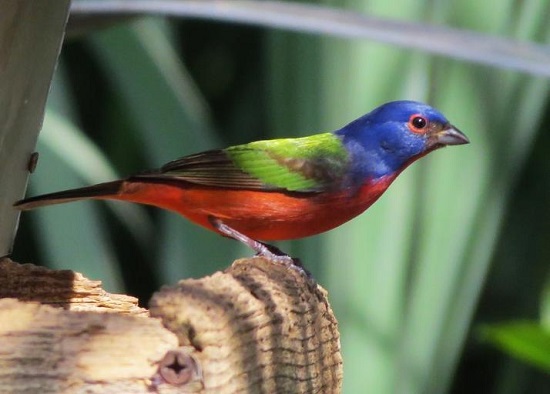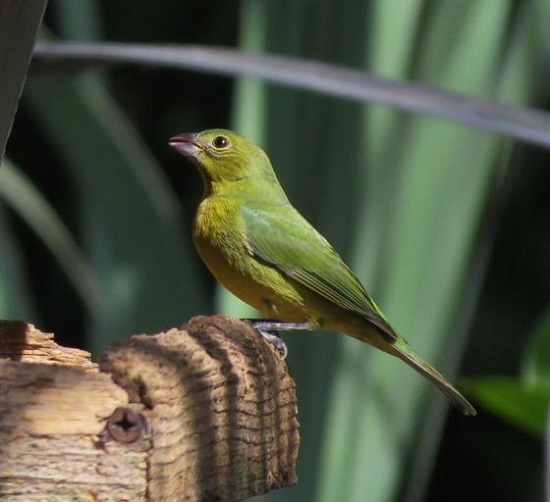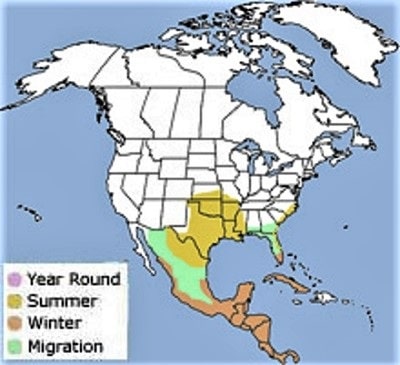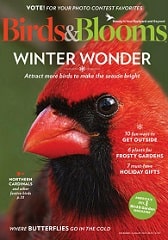Painted Bunting Bird: Our Most Colorful Bird
The Painted Bunting bird is considered one of North America's most colorful birds and is found mostly in the southern United States.
Along with the Varied Bunting, the Painted Bunting stands out as a gorgeous bird known for its vibrant plumage.
While technically not a rare or endangered species, their populations are declining in the east because of habitat loss and predation.
The eastern population breeds primarily in dense thickets and edge habitats, but this loss of habitat has significantly affected them.
In contrast, their populations remain steady or have slight increases in other regions.
Description: Male
It's the male Painted Bunting that gets noticed first. He will not get his full adult plumage until his second season some 15 to 18 months after hatching.
With a blue head, red underparts, and distinctive bright green wings and back, he presents a vivid fusion of colors. His rump is also red.
The length of this sparrow-sized bird is about 5 to 5 1/2 inches.

Male Painted Bunting
Female Appearance: Field Marks, Size
There's quite a difference between male and adult female Painted Buntings.
While the males boast vivid blue, green, red, and yellow plumage, the small greenish birds (females and immature males) are greenish with yellowish-green underparts, which provide the camouflage they need in their dense foliage habitat.

Female Painted Bunting
Song
The male Painted Bunting produces a complex and varied song during the breeding season.
The song comprises a combination of whistles, warbles, and trills, creating a unique and intricate melody.
This is a common trait in common songbirds like the Painted Bunting.
The purpose of the song is primarily to attract a mate, showcasing the male's reproductive fitness.
Territory Defense Call
Painted Buntings also emit a sharp, metallic "chip" or "tink" call, often repeated rapidly.
This call serves territorial purposes and is employed during the defense of breeding territories.
This behavior is similar to other birds like blue jays or the blue grosbeak.
Females have softer calls, particularly during interactions within the pair and with nestlings.
Breeding And Nesting Season
The breeding season for Painted Buntings begins in mid-April and can go through August for a second brood, with some pairs nesting as late as late August.
Painted Buntings are migratory birds, spending their winters in scrub communities of South Florida, parts of Central America, and the Caribbean.
Returning to their breeding grounds throughout coastal southern U.S. and parts of the Midwest in the spring and summer.
Males arrive on their territories about a week before the females. They sing their song to attract a mate and assert dominance.
Once paired, the female buntings select the nest site and begin nest building.
Where They Nest
Their nesting habits are notable for their preference for dense thickets, edges of coastal oak hammocks, and small trees, which offer protection from predators while raising young.
Males and females participate in nest site selection, but it is the female who builds the nest.
Nests are typically completed in 2 to 5 days.
| Painted Bunting Nesting Stats | |
|---|---|
| Eggs | 3 - 5 |
| Incubation | 11 - 12 days |
| Nestling Phase | 12- 14 days |
| Broods | 1 - 2 |
The female weaves together a variety of materials, including grass, leaves, and spiderwebs, forming a cup-shaped structure.
It is hidden in dense vegetation, often less than 10 feet above ground, providing camouflage from predators like the brown-headed cowbird, which often lays its eggs in the nests of other birds.
The deeply cupped nest is about 3 1/4 inches wide and 2 1/2 inches deep.
Egg Laying and Incubation
The female Painted Bunting will lay one egg each day until she completes a clutch of 3 to 5 eggs. These pale blue or dull white eggs are speckled, especially on the larger end.
The female incubates them for 11-12 days, and the nestlings will remain in the nest for 12-14 days.
During this time, the female feeds the chicks beetles, caterpillars, and grasshoppers.
After the young leave the nest, the male continues feeding them until they can fend for themselves.
While the male is feeding the young, the female begins a new clutch. She may build a new nest or reuse the first nest.
Feeding Habits
Painted Bunting birds have a diverse diet that includes a variety of seeds and insects.
Their foraging strategy adapts to the availability of food resources, which changes with the seasons.
During the breeding season, they are especially reliant on insect protein to feed their chicks, favoring caterpillars, spiders, and grasshoppers among other invertebrates.
In the fall and winter months, they shift to seeds and grains, foraging in open areas like fields and gardens.
Geographical Range

- Breeding Range: They breed primarily in the southern United States, including states like North Carolina, South Carolina, Georgia, Florida, and parts of Texas, Oklahoma, and Kansas.
- Wintering Range: Buntings winter (migrate) in Central America, South Florida, and the Caribbean.
- Migration Pathways: Painted Buntings utilize both coastal and inland migration routes.
Preferred Habitat
Breeding habitats include edge habitats near water while wintering habitat includes scrub communities, gardens, and farmlands.
The availability of food and nesting sites influences their habitat selection.
Fall Migration
Painted Buntings migrate to the southeastern U.S., arriving by October and staying through the winter before returning north for breeding.
Their winter population in places like Florida is monitored by birders and BBS routes.
Conservation Status
While Painted Buntings are currently listed as Least Concern on the IUCN Red List, habitat loss, especially in open areas and scrub communities, threatens their populations.
Conservationists use climate models to predict how changes in climate and habitat availability might impact future populations.
Despite protection by the U.S. Fish and Wildlife Service, Painted Buntings are still legally traded in certain countries.
Efforts to maintain their habitats and raise awareness through birdwatching groups and bird guide texts are critical in ensuring their survival.



